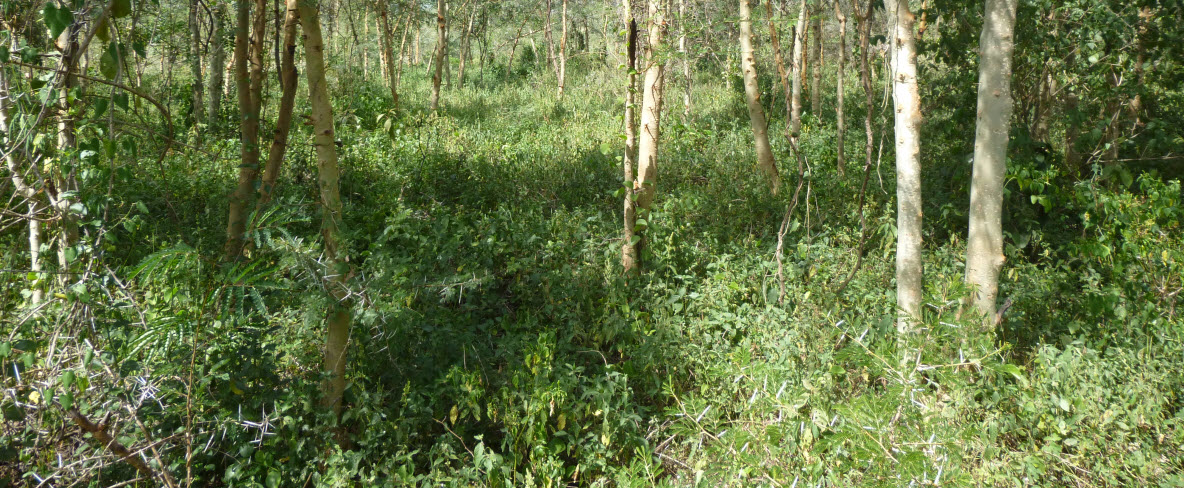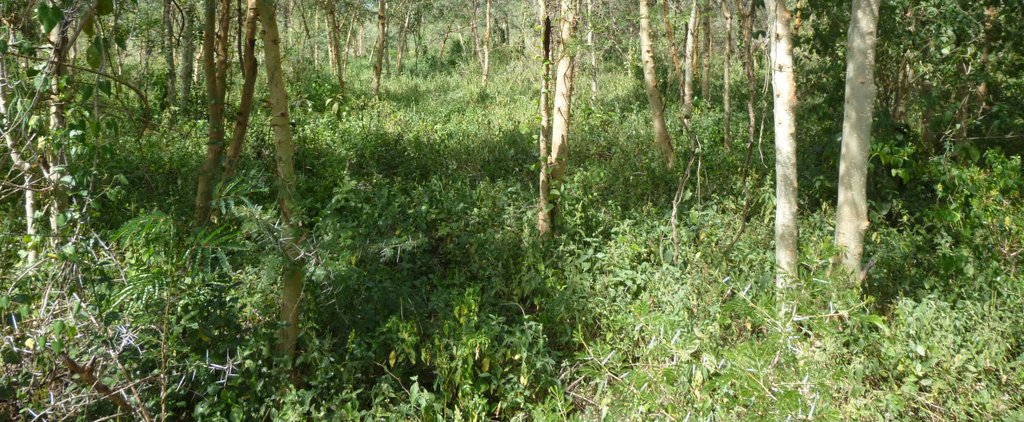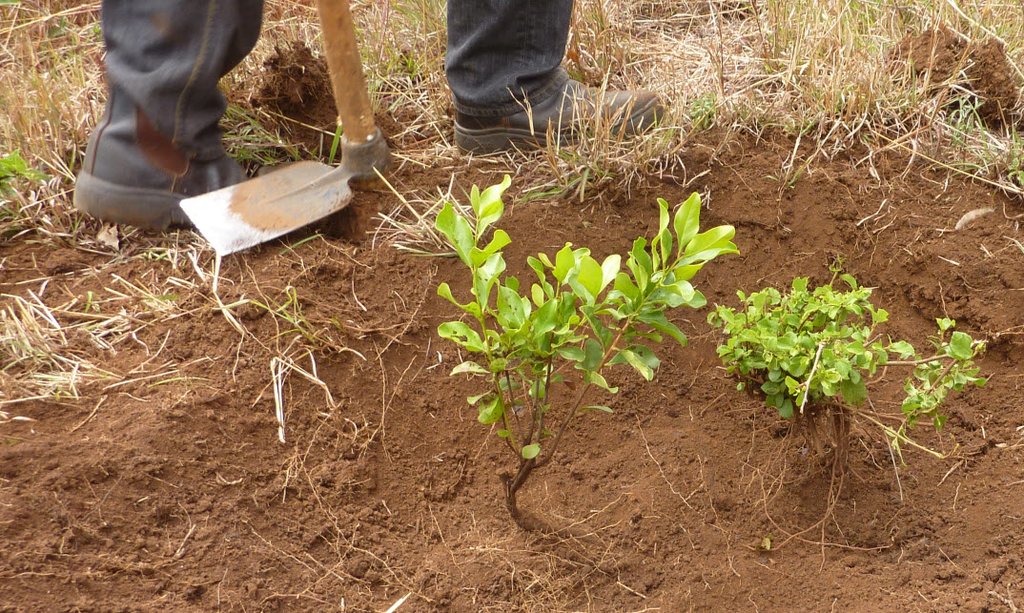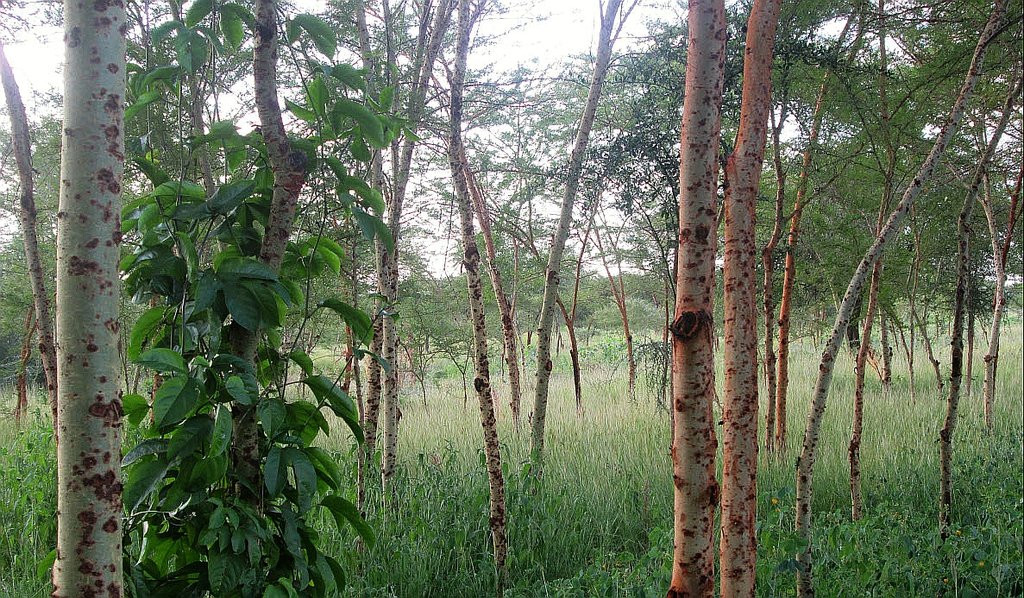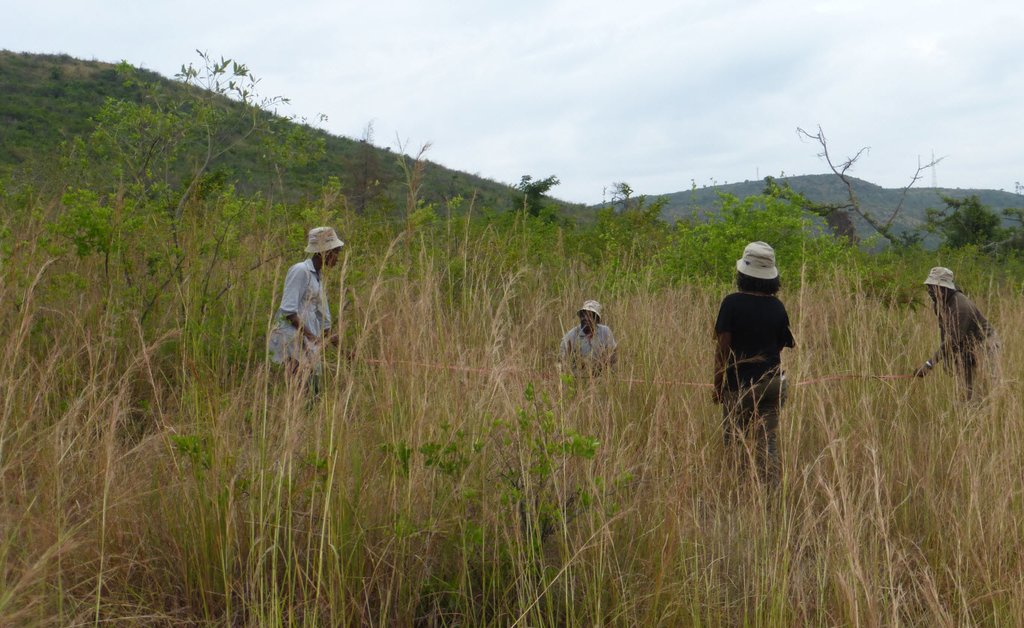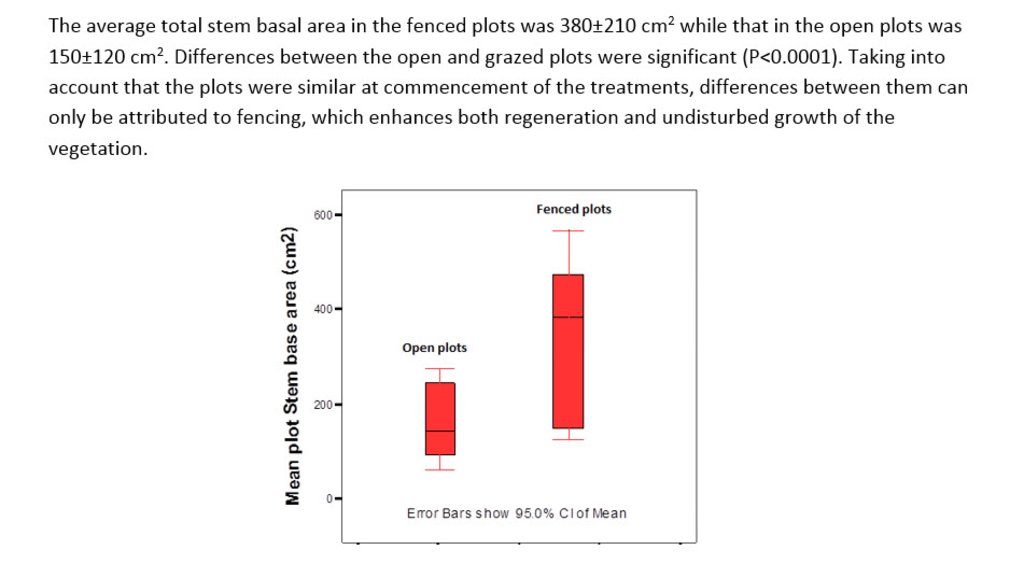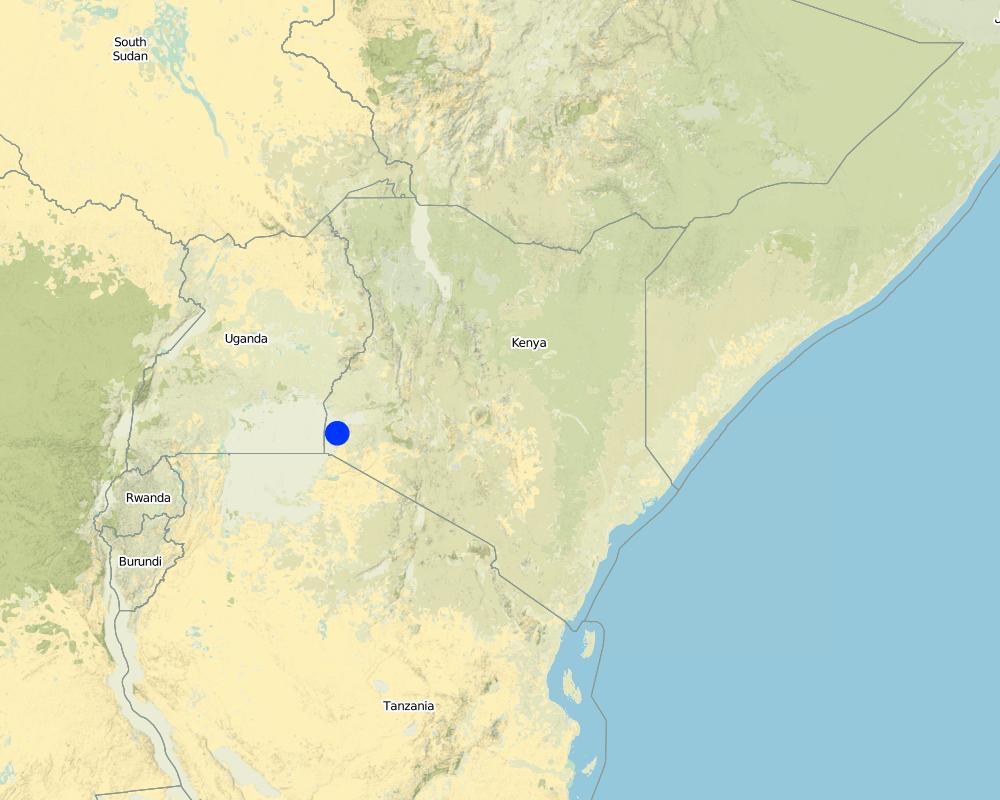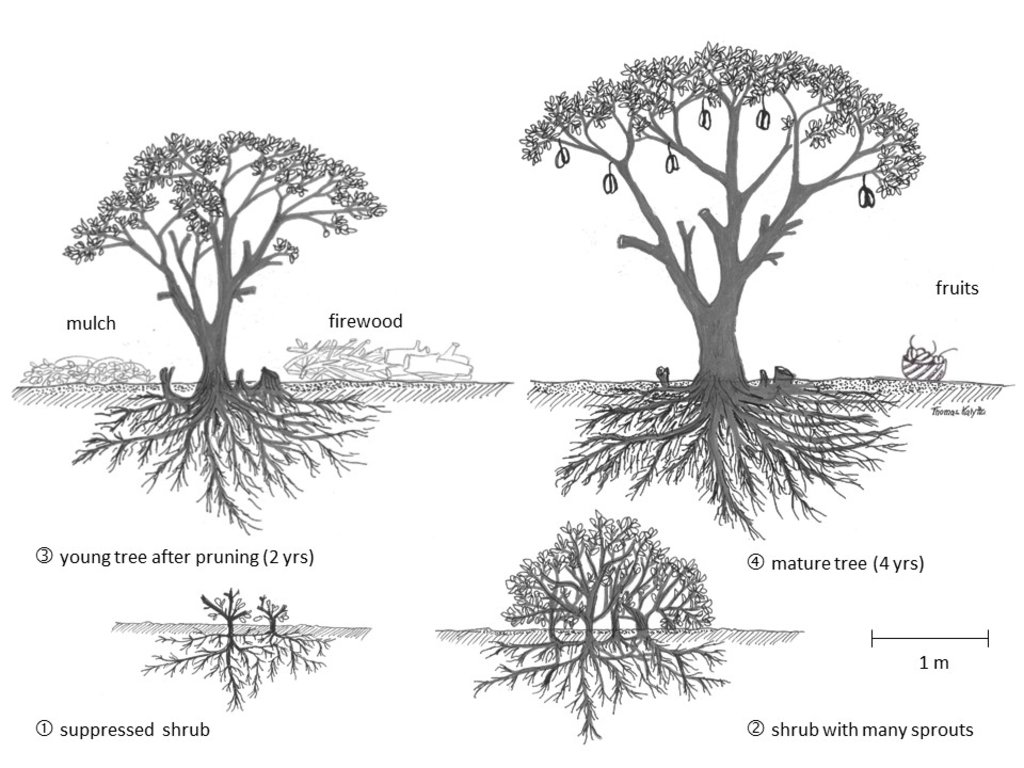Farmer Managed Natural Regeneration (FMNR) [Quênia]
- Criação:
- Atualização:
- Compilador/a: Thomas Kalytta
- Editor: Irene Ojuok
- Revisores: Hanspeter Liniger, Nicole Harari, Alexandra Gavilano, David Streiff, Fabian Ottiger, Mathias Gurtner
FMNR
technologies_507 - Quênia
Veja as seções
Expandir tudo Recolher tudo1. Informação geral
1.2 Detalhes do contato das pessoas capacitadas e instituições envolvidas na avaliação e documentação da tecnologia
Pessoa(s) capacitada(s)
Especialista em GST:
Ojuok Irene
+254725859689
Irene_Ojuok@wvi.org
World Vision
Lambwe Valley ADP Office, Homabay, Kenya
Quênia
Kalytta Thomas
0041445101593
thomas_kalytta@wvi.org
World Vision
Kriesbachstrasse 30, 8600 Dübendorf, Switzerland
usuário de terra:
Sijenyi Onyiego William
0727369635 / 0708297048
N/A
Obanda Environmental project
Mbita Sub County, Dr Tom Mboya Okeyos Farm along Mbita Homabay Road. The site is by the road side.
Quênia
Nome do projeto que facilitou a documentação/avaliação da Tecnologia (se relevante)
Book project: where people and their land are safer - A Compendium of Good Practices in Disaster Risk Reduction (DRR) (where people and their land are safer)Nome da(s) instituição(ões) que facilitou(ram) a documentação/ avaliação da Tecnologia (se relevante)
World Vision (World Vision) - Suíça1.3 Condições em relação ao uso da informação documentada através de WOCAT
Quando os dados foram compilados (no campo)?
16/09/2016
O/a compilador/a e a(s) pessoa(s) capacitada(s) aceitam as condições relativas ao uso de dados documentados através da WOCAT:
Sim
1.4 Declaração de sustentabilidade da tecnologia descrita
A tecnologia descrita aqui é problemática em relação a degradação da terra de forma que não pode ser declarada uma tecnologia de gestão sustentável de terra?
Não
Comentários:
It is a very sustainable technology as it promotes the natural regeneration of highly degraded areas.
1.5 Referência ao(s) questionário(s) sobre as abordagens da GST
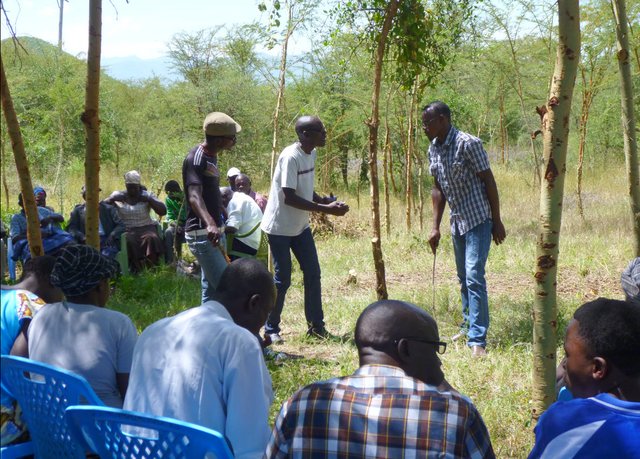
FMNR implementation approach [Quênia]
After consultations with local stakeholders, experts (from NEMA, ICRAF, KFS, Wildlife Kenya) and Homabay County Government representatives the FMNR approach is being introduced by World Vision through a public funded project. The aim of the approach is to promote FMNR and sustainable land and natural resource management through disseminating the …
- Compilador/a: Thomas Kalytta
2. Descrição da tecnologia de GST
2.1 Descrição curta da tecnologia
Definição da tecnologia:
Farmer Managed Natural Regeneration (FMNR) is a proven SLM Technology to restore degraded wasteland and improve depleted farmland. The farmer regu- lates and facilitates the re-growth of existing trees stumps, or self-sown seeds in the soil, and thus promotes soil fertility and through better ground cover, increases protection from runoff and erosion.
2.2 Descrição detalhada da tecnologia
Descrição:
Conventional afforestation and tree planting requires considerable inputs, labour and care including suitable seedlings, transport of these, planting and regular watering - and the survival rate in arid and semi-arid climates is often very poor. On the other hand Farmer Managed Natural Regeneration (FMNR) is a cheap and effective way to restore and improve large areas of degraded and depleted soils. The technology relies on the fact that even in deforested areas, soils often still maintain some active roots systems and viable seeds of native woody plants. Selectively promoted, leaving only a few main shoots, they can grow into trees within a few years. This technology - based on indigen- ous practices - has been successfully promoted by World Vision in eight African countries including Kenya and Ethiopia, and is now also being applied in Indonesia, East Timor and Latin America. Apart from labour and a farmer’s knife, and skills, there are no major inputs required. The farmers like this agroforestry technology a it is cheap and can be easily combined with other SLM technolo- gies such as permaculture, inter-cropping, and mulching. At the same time it can be used at various scales: on small plots of less than one hectare or up to the landscape level where whole hills can be re-vegetated within a short period. And the impact can be very positive on the soil, ecology, cli- mate and health of crops, people and livestock. The farmer can use prunings as rewood, and grow fodder below the trees; tree branches and leaves can serve for mulching and the owers for bees, fruits for consumption and sale. The trees break the winds, protect the soil and (with some species) their shade protects sensitive crops (e.g. vegetables or even coffee) from the sun. The soil’s water retention capacity, structure, biology and fertility improve. All effects contribute to soil, water and climate stabilization. One limitation can be the use of tractors and other machines which, however, are hardly employed by smallholder farmers. Some practical steps for establishing an FNMR site; 1) jointly agree on a target area (be it a eld or communal wasteland) 2) check out the area carefully for existence of woody species (trees, bushes, rootstocks) 3) mark the bushes or trees that should be nurtured into bigger trees (it is recommended to consult local/scientific knowledge on the trees species and their positive benefits) 4) protect the whole area (fences, hedges) or only the chosen trees against grazing and human disturbance 5) when the plants reach a height of 1 m start with pruning, only keeping the 2-3 main shoots, using the prunings for rewood or mulching 6) watering is in most cases not required as the indigenous trees have well-enough developed roots for self- supply 7) the specific cultivation and management practice depends on the trees species selected and the desired results (intercropping with maize, shade trees for coffee, fodder trees for livestock, flower trees for bees etc.) 8) fire and livestock are the are the main threats for a new FMNR site.
2.3 Fotos da tecnologia
Observações gerais sobre as fotos:
The photos were taken during 2 years while introducing FMNR to the 1000 small holder farmers in Homabay County.
2.4 Vídeos da tecnologia
Comentários, breve descrição:
Tony Rinaudo gives an introduction to Farmer Managed Natural Regeneration Project Model. It is something that can be implemented relatively quickly with a low budget and have a great impact. FMNR has big implications for income generation, Disaster Risk Reduction, reducing proness to famine, conflict reduction, land and forest restoration, food security, climate change adaptation and mitigation... amongst other things.
https://vimeo.com/55277450
Data:
2012
Localização:
Niger etc.
Nome do cinegrafista:
World Vision
Comentários, breve descrição:
(Video in German language)
It is a method with a great success: Farmer Managed Natural Regeneration (FMNR). World Vision employee Tony Rinaudo paves the way to grow trees, where hardly anything is produced. Meanwhile, the people in the Humbo region of Ethiopia are earning money from global emissions trade through greening their country. The World Bank is promoting the project and the local people can now provide for a better future. But in the beginning it was not easy for Tony Rinaudo and his colleagues to convince the farmers to protect the forest!
Es ist eine Methode, die durchschlagenden Erfolg hat: Farmer Managed Natural Regeneration (FMNR).
World Vision Mitarbeiter Tony Rinaudo lässt Bäume aufwachsen, wo das Land kaum noch etwas hervorbringt. Mittlerweile verdienen die Menschen in der Region Humbo in Äthiopien durch die Wiederbegrünung Geld im weltweiten Emissionshandel. Die Weltbank fördert das Projekt und die Menschen vor Ort können nun selbst für eine bessere Zukunft sorgen. Doch am Anfang war es nicht leicht für Tony Rinaudo und seine Mitstreiter, die Bauern davon zu überzeugen den Wald zu schützen!
https://vimeo.com/189822143
Data:
26/06/2012
Localização:
Humbo, Ethiopia
Nome do cinegrafista:
World Vision
Comentários, breve descrição:
Original (edited) footage of a 1990 visit to Niger where Farmer Managed Natural Regeneration (FMNR) was being practiced. Features an interview with Tony Rinaudo and one of the early adopters. Tony was a SIM missionary who pioneered and developed this management practice. It is now being practiced on millions of hectares in Niger and other countries in the Sahel. Part 1: https://vimeo.com/189821376
Part 2: https://vimeo.com/189821948
Data:
1990
Localização:
Niger
Nome do cinegrafista:
Barry Rands
2.5 País/região/locais onde a tecnologia foi aplicada e que estão cobertos nesta avaliação
País:
Quênia
Região/Estado/Província:
Homa Bay Country
Especificação adicional de localização:
Suba and Mbita Sub-Counties
Comentários:
Only 16 of the initial FMNR sites are reflected above:
1,-0.55,34.215,1202,Sumba West ,Lambwe,Abong'o agroforestry farm,Mon Sep 01 00:00:00 UTC 2014,Yes,Borehole 4,Bucket or watering can,1,0,1,"Agroforestry management,soil testing and +fmnr",4
2,-0.546,34.209,1223,Sumba west ,Lambwe,Abuto's +fmnr,Fri Aug 01 00:00:00 UTC 2014,Yes,Borehole,N/A,1,0,1,+fmnr farm,,https://wvksurveys.appspot.com/view/binaryData?blobKey=WVK_Livelihoods_2014%5B%40version%3Dnull+and+%40uiVersion%3Dnull%5D%2FWVK_Livelihoods_2014%5B%40key%3Duuid%3A7afa8c53-61f2-46ff-a191-9ebd393b0145%5D%2Fimage_test
4,-0.617,34.333,1171,Ogongo ,Lambwe,Aloice +fmnr demonstration farm,Sat Sep 13 00:00:00 UTC 1997,Yes,"Borehole, Rainwater, lake and Others",N/A,1,0,1,+fmnr Demonstration farm.,3
5,-0.621,34.331,1154,Ogongo ,Lambwe,Arise and Shine Ojawa YG,Wed Jan 01 00:00:00 UTC 2014,Yes,Pond,Bucket or watering can,11,5,6,"Tree nursery, tree planting, +fmnr, bee keeping, maize farming 4acres, Agro forestry, chairs for hire, fruit trees.",10
6,-0.612,34.337,1191,Ogongo ,Lambwe,Clements +fmnr site,Tue Aug 13 00:00:00 UTC 2013,Yes,"Rainwater, lake and Others",N/A,2,1,1,+fmnr established site,1 acre,https://wvksurveys.appspot.com/view/binaryData?blobKey=WVK_Livelihoods_2014%5B%40version%3Dnull+and+%40uiVersion%3Dnull%5D%2FWVK_Livelihoods_2014%5B%40key%3Duuid%3Af68584de-5b53-465a-9177-01159ef0ff3f%5D%2Fimage_test
7,-0.541,34.392,1163,Ruri East,Lambwe,Eliakims +fmnr site,Sun Jun 01 00:00:00 UTC 2014,Yes,Borehole,N/A,1,1,1,Household +fmnr site and bee keeping.,2 acres,https://wvksurveys.appspot.com/view/binaryData?blobKey=WVK_Livelihoods_2014%5B%40version%3Dnull+and+%40uiVersion%3Dnull%5D%2FWVK_Livelihoods_2014%5B%40key%3Duuid%3A825648e7-1fa4-4be8-b051-83adc8748e0b%5D%2Fimage_test
10,-0.562,34.324,1204,Got jope ,Lambwe,Got Jope +fmnr Biodiversity site,Wed Aug 13 00:00:00 UTC 2014,Yes,"Rainwater, lake and Others",N/A,0,,,+fmnr site fenced off for natural re generation,2
11,-0.535,34.406,1172,Got Rabondo,Lambwe,Gotrabondo +fmnr,Tue Jan 13 00:00:00 UTC 2015,Yes,"Rainwater, lake and Others",N/A,,,,Proposed +fmnr site,0.5 acres,https://wvksurveys.appspot.com/view/binaryData?blobKey=WVK_Livelihoods_2014%5B%40version%3Dnull+and+%40uiVersion%3Dnull%5D%2FWVK_Livelihoods_2014%5B%40key%3Duuid%3A544ec602-66ad-4e15-9053-1471c78f53ad%5D%2Fimage_test
19,-0.576,34.368,1243,Godjope,Lambwe,Ngufu youth group,Tue Jan 06 00:00:00 UTC 1998,Yes,Open well,Bucket or watering can,7000,4500,2500,+fmnr site,6Average of 2.5acres per household,https://wvksurveys.appspot.com/view/binaryData?blobKey=WVK_Livelihoods_2014%5B%40version%3Dnull+and+%40uiVersion%3Dnull%5D%2FWVK_Livelihoods_2014%5B%40key%3Duuid%3Ae64b2ac5-0beb-4780-aa51-595c3a31d3c7%5D%2Fimage_test
22,-0.6,34.25,1336,Nyandenda ,Lambwe,Nyakia CBO,Tue Jan 03 00:00:00 UTC 2012,Yes,Open well,Bucket or watering can,35,15,20,"Bee keeping, +fmnr, Agro forestry",0.5 acres,https://wvksurveys.appspot.com/view/binaryData?blobKey=WVK_Livelihoods_2014%5B%40version%3Dnull+and+%40uiVersion%3Dnull%5D%2FWVK_Livelihoods_2014%5B%40key%3Duuid%3A792b57df-7a7f-4e43-9643-8d801e3b39be%5D%2Fimage_test
26,-0.546,34.343,1234,God jope ,Lambwe,Obanda environmental group,Tue Jul 01 00:00:00 UTC 2014,Yes,"Rainwater, lake and Others",Bucket or watering can,7,2,5,"+fmnr , tree nursery and soil and water conservation",20 acres,https://wvksurveys.appspot.com/view/binaryData?blobKey=WVK_Livelihoods_2014%5B%40version%3Dnull+and+%40uiVersion%3Dnull%5D%2FWVK_Livelihoods_2014%5B%40key%3Duuid%3A73b33675-a5be-4579-b31a-51ec366c6c6f%5D%2Fimage_test
28,-0.599,34.335,1175,Ogongo ,Lambwe,Ogando youth group,Sat Oct 13 00:00:00 UTC 2012,Yes,Pond,Bucket or watering can,19,6,13,"Tree nursery, kitchen vegetable gardening, tree planting, agroforestry, proposed green house farming, proceeds from tree nursery support livestock purchase, fruit tree I.e grafted mangoes, +fmnr",4 acres,https://wvksurveys.appspot.com/view/binaryData?blobKey=WVK_Livelihoods_2014%5B%40version%3Dnull+and+%40uiVersion%3Dnull%5D%2FWVK_Livelihoods_2014%5B%40key%3Duuid%3A70cf4828-4a0d-4ae5-a122-ce3654cb8242%5D%2Fimage_test
32,-0.528,34.172,1122,Sindo ,Lambwe,Osumbas +fmnr farm,Wed Jul 02 00:00:00 UTC 2014,Yes,"Rainwater, lake and Others",N/A,,,,+fmnr farm ,3 acres,https://wvksurveys.appspot.com/view/binaryData?blobKey=WVK_Livelihoods_2014%5B%40version%3Dnull+and+%40uiVersion%3Dnull%5D%2FWVK_Livelihoods_2014%5B%40key%3Duuid%3Ac8c7fa0c-80a6-4790-bddc-d4ac003bc4ba%5D%2Fimage_test
34,-0.547,34.169,1136,Rang'wa East ,Lambwe,Samuel obado Demonstration farm,Wed May 14 00:00:00 UTC 2014,Yes,"Rainwater, lake and Others",Bucket or watering can,1,0,1,+fmnr Demonstration farm.,3
37,-0.623,34.25,1213,Nyandenda ,Lambwe,Violet simba-individual,Tue Jan 03 00:00:00 UTC 2012,Yes,Open well,Bucket or watering can,1,1,0,"+fmnr Agro forestry, fruit trees, bee keeping, tree nursery",3
Map
×2.6 Data da implementação
Indique o ano de implementação:
2014
Caso o ano exato seja desconhecido, indique a data aproximada:
- menos de 10 anos atrás (recentemente)
2.7 Introdução da tecnologia
Especifique como a tecnologia foi introduzida:
- através de projetos/intervenções externas
Comentários (tipos de projeto, etc.):
The technology was introduced by World Vision through a public funded project on climate protection and natural resource management. It received the “Total Kenya Eco Challenge Award” in 2016. The introduction was done through the following steps. The project staff were trained on the concept after which they trained Government staff in forestry, education and agriculture department including chiefs and assistant chief who were to turn out to be the entry point/ ambassadors for the concept. Intense trainings, awareness campaigns, practical demonstrations, consultative meetings and observations were conducted. Till now more than 300 hectares of degraded land was reclaimed through FMNR and over 1000 farmers adopted the practice already.
3. Classificação da tecnologia de GST
3.1 Principal/principais finalidade(s) da tecnologia
- Melhora a produção
- Reduz, previne, recupera a degradação do solo
- Preserva ecossistema
- Protege uma bacia/zonas a jusante – em combinação com outra tecnologia
- Preservar/melhorar a biodiversidade
- Reduzir riscos de desastre
- Adaptar a mudanças climáticas/extremos e seus impactos
- Atenuar a mudanças climáticas e seus impactos
- Criar impacto econômico benéfico
- this technology brings a lot of positive effects on the environment (more water, more carbon and nutrients in the soil, better micro climate etc.) > bullet point 4: other technologies could be contour farming, agroforestry, water harvesting)
3.2 Tipo(s) atualizado(s) de uso da terra onde a tecnologia foi aplicada

Misto (plantação, pastagem, árvores) inclusive agrofloresta
- Agrofloresta
Principais produtos/serviços:
The native trees provide shade, organic matter, fruits, fodder, firewood, bee pasture etc.
Typical crops in Kenya grown below the FMNR trees are maize, millet, mung beans, amaranth and sorghum, vegetables and coffee. It can be an advantage to promote the growth of Leguminous trees as they serve as source of nitrogen and many of them produce pods eaten by livestock.

Terra improdutiva
Especifique:
degraded wasteland
Observações:
Many of the typical hills and areas in Suba Sub-County are degraded and without forest anymore. Over exploitation through grazing and charcoal burning led to deforestation and soil degradation. Most of the water streams have disappeared in the meantime. The climate has become more harsh and arid. The native trees grown through FMNR provide shade, organic matter, fruits, fodder, fire wood, bee pasture etc.
3.3 Mais informações sobre o uso da terra
Abastecimento de água para a terra na qual a tecnologia é aplicada:
- Precipitação natural
Comentários:
Since only indigenous species are promoted the normal rainfall should be sufficient for their growth.
Número de estações de cultivo por ano:
- 1
Especifique:
There is no planting required but protection of FMNR plots. The shrubs grow best in the rainy season.
Densidade animal (se relevante):
Livestock is one of the main threats to the technology. It is a very important to keep livestock out of the FMNR areas either by using live fences or mesh wire fences.
3.4 Grupo de GST ao qual pertence a tecnologia
- Gestão natural e seminatural de floresta
- Agrofloresta
- Solo/cobertura vegetal melhorada
3.5 Difusão da tecnologia
Especifique a difusão da tecnologia:
- Uniformemente difundida numa área
Caso a tecnologia seja uniformemente difundida numa área, indique a área coberta aproximada:
- 1-10 km2
Comentários:
There are many more project sites facilitated through World Vision in Kenya where this technology is being applied e.g. in Baringo (Wema, Mogotio) and Samburu (Poro).
3.6 Medidas de GST contendo a tecnologia

Medidas vegetativas
- V1: cobertura de árvores/arbustos
Comentários:
There is also an aspect of management change (M2): allowing the native trees to grow, pruning of upcoming bushes, mulching with tree branches, felling of trees when desired etc.
3.7 Principais tipos de degradação da terra abordados pela tecnologia

Erosão do solo pela água
- Wt: Perda do solo superficial/erosão de superfície
- Wg: Erosão por ravinas/ravinamento

Erosão do solo pelo vento
- Et: Perda do solo superficial

Degradação biológica
- Bc: redução da cobertura vegetal
- Bq: quantidade/ declínio da biomassa
- Bs: Qualidade e composição de espécies/declínio de diversidade
Comentários:
FMNR contributes to less soil erosion, more organic matter and more diversified habitats (leading to increased agro-biodiversity).
3.8 Redução, prevenção ou recuperação da degradação do solo
Especifique o objetivo da tecnologia em relação a degradação da terra:
- Reduzir a degradação do solo
- Recuperar/reabilitar solo severamente degradado
Comentários:
FMNR contributes to less land degradation and is an ideal technology to restore severely degraded areas.
4. Especificações técnicas, implementação de atividades, entradas e custos
4.1 Desenho técnico da tecnologia
4.2 Especificações técnicas/ explicações do desenho técnico
The technical drawing above shows four typical stages of an indiginous tree in a FMNR site:
1) a suppressed shrub, very damaged by roaming animals or human interference
2) if this small shrub experience protection it will regenerate and grow many new branches
3) as soon as a bush has reached a height of 1 m the farmer can start with pruning keeping only a few major branches. This will help the tree to grow high and the farmer can yield branches and leaves for fire wood and mulching. Depending on the growth rate, pruning can be done 1-2 times a year.
4) A mature tree produces also fruits that can be harvested. As only major branches remain enough sunlight will reach the ground to allow the cultivation of crops or gras production.
Slope and spacing can varry a lot (from 5 to 50 m distance) as FMNR is designed to be extremely flexible, giving farmers considerable freedom of individual choice on how to meet their own specific needs, using the free materials at hand (species mix), responding to the specific climate, soils, crop mix, and their own understanding, at the time of implementation. FMNR is being introduced into many different contexts where the environment and species mix, the specific land use (crop land, pasture or forest) and farmer needs, vary from region to region and even from farm to farm.
To date, FMNR has been successfully practiced in a variety of locally adapted ways such as:
- By individual farmers on their own land
- By communities on communal lands and in degraded forests
- By leaving very few trees (10 - 20 / ha), or by leaving very many (150 trees/ ha).
- By focusing on tree species predominantly used to provide firewood and building poles, or on species that have nutritious leaves that feed families or animals. Some use trees that fix nitrogen and can therefore increase the soil fertility for crops.
- Leaving a single stem to grow from a stump (and harvesting when larger), or by leaving multiple stems,
successively harvesting one each year.
- Allowing a single stem to grow into a permanent tree, and then harvesting 1/2 to 1/3rd of the branches per
year (such as pollarding). Pollarding provides larger wood harvests and more rapid re-growth.
- Allowing tree re-growth only on farm borders. The trees are allowed to grow close to each other and are
pruned high up the trunk. As need arises whole trees are harvested and re-growth is allowed to replace
the tree that was harvested.
- Leaving only trees, which are growing approximately in straight lines and moving self-sown seedlings and replanting them within these lines. Within the rows the trees are grown as bushes which are slashed to
ground level during the rainy season, except for single stems that are allowed to grow about every 12
meters. This is done to avoid interference with ploughing and because soil infertility is a major issue,
addressed by mulching with pruned branches.
4.3 Informação geral em relação ao cálculo de entradas e custos
Especifique como custos e entradas foram calculados:
- por área de tecnologia
Indique o tamanho e a unidade de área:
1
Caso esteja usando uma unidade de área local, indique o fator de conversão para um hectare:
ha
Outro/moeda nacional (especifique):
KES
Indique a taxa cambial do dólar norte americano para a moeda local (se relevante): 1 USD =:
100,0
Indique a média salarial da mão-de-obra contratada por dia:
400 Kenyan Shillings
4.4 Atividades de implantação
| Atividade | Tipo de medida | Periodicidade | |
|---|---|---|---|
| 1. | Plot inspection (to identify and mark potential bushes) | Vegetativo | ideally after harvesting the crops, best time for transects |
| 2. | Plot protection (fencing against livestock) | Estrutural | ideally after harvesting, best time for transects, before planting |
| 3. | alternatively: Protection measures of single bushes | Estrutural | ideally after harvesting, best time for transects, before planting |
| 4. | Weeding/ clearance of surplus bushes/ vegetation | Agronômico | all year, during vegetation period |
| 5. | normal farming activities within the FMNR site | Agronômico | after harvesting the crops |
| 6. | Integrating beekeeping and or fodder harvesting | Agronômico | all year, during vegetative period |
| 7. | Thinning or harvesting of fuel wood | Gestão | As per need, dependant on the farmer, all year round |
Comentários:
Ideally, FMNR activities are not interfering too much with the normal farming activities except for mulching or compost making wherefore small tree branches can be used.
4.5 Custos e entradas necessárias para a implantação
Se possível, discrimine os custos de implantação de acordo com a seguinte tabela, especificando entradas e custos por entrada. Se não for possível, dê uma estimativa dos custos totais de implantação da tecnologia:
32600,0
| Especifique a entrada | Unidade | Quantidade | Custos por unidade | Custos totais por entrada | % dos custos arcados pelos usuários da terra | |
|---|---|---|---|---|---|---|
| Mão-de-obra | plot protection - fencing/ ha | person-days | 30,0 | 400,0 | 12000,0 | 100,0 |
| Mão-de-obra | tree protection - first pruning/ ha | person-days | 10,0 | 400,0 | 4000,0 | 100,0 |
| Equipamento | farmer's knife | piece | 2,0 | 150,0 | 300,0 | 100,0 |
| Equipamento | machete | piece | 2,0 | 500,0 | 1000,0 | 100,0 |
| Equipamento | rake | piece | 2,0 | 500,0 | 1000,0 | 100,0 |
| Equipamento | hand hoe | piece | 2,0 | 450,0 | 900,0 | 100,0 |
| Equipamento | leather gloves | pair | 2,0 | 1000,0 | 2000,0 | 100,0 |
| Equipamento | strong gumboots | pair | 2,0 | 2000,0 | 4000,0 | 100,0 |
| Equipamento | axe | piece | 2,0 | 700,0 | 1400,0 | 100,0 |
| Material vegetal | life fence seeds/ thorns of shrubs / ha | seedlings | 1200,0 | 5,0 | 6000,0 | 100,0 |
| Fertilizantes e biocidas | n/a | |||||
| Material de construção | n/a | |||||
| Outros | n/a | |||||
| Custos totais para a implantação da tecnologia | 32600,0 | |||||
Se o usuário da terra arca com menos que 100% dos custos, indique quem cobre os custos remanescentes:
The farmer harvest wood and non-wood products like honey and grass. Often FMNR is combined with agriculture or animal husbandry. As the crop yield increases the farmer can invest in more equipment and tools.
Comentários:
Some of the costs incurred were covered by WV during inception of the project model of FMNR especially for the demonstration plots but the costs on household level are covered by the farmers themselves. Normal farm equipment is being used to establish the sites. The farmer needs some gloves und gumboots and the time for the additional works. Also some time is needed to be invested for training to get equipped with the required knowledge and skills. Live fence plants or throns from shrubs are normally collected/ taken from the pruned Acacia branches.
4.6 Atividades recorrentes/manutenção
| Atividade | Tipo de medida | Periodicidade/frequência | |
|---|---|---|---|
| 1. | Pruning of target bushes and trees | Vegetativo | during vegetation period, ideally in the dry season |
| 2. | tree felling | Vegetativo | after vegetation period, after harvesting the crops |
| 3. | Harvesting of grass in FMNR sites not on crops | Vegetativo | During and after rainny season |
Comentários:
Ideally, FMNR activities are not interfering too much with the normal farming activities except for mulching or compost making wherefore small tree branches can be used for firewood. In places where FMNR is applied to gain timber, branches and firewood in a sustainable way, it has supported to raise more income for households allowing them to meet their basic needs including school fees, medical bills etc.
4.7 Custos e entradas necessárias pata a manutenção/atividades recorrentes (por ano)
Se possível, discrimine os custos de manutenção de acordo com a seguinte tabela, especificando entradas e custos por entrada. Se não for possível, dê uma estimativa dos custos totais de manutenção da tecnologia:
14600,0
| Especifique a entrada | Unidade | Quantidade | Custos por unidade | Custos totais por entrada | % dos custos arcados pelos usuários da terra | |
|---|---|---|---|---|---|---|
| Mão-de-obra | Yearly Pruning of target bushes and trees /ha | person-days | 6,0 | 400,0 | 2400,0 | 100,0 |
| Mão-de-obra | tree felling of selected trees/ ha | person-days | 4,0 | 400,0 | 1600,0 | 100,0 |
| Equipamento | farmer's knife | piece | 2,0 | 150,0 | 300,0 | 100,0 |
| Equipamento | machete | piece | 2,0 | 500,0 | 1000,0 | 100,0 |
| Equipamento | rake | piece | 2,0 | 500,0 | 1000,0 | 100,0 |
| Equipamento | hand hoe | piece | 2,0 | 450,0 | 900,0 | 100,0 |
| Custos totais para a manutenção da tecnologia | 7200,0 | |||||
Se o usuário da terra arca com menos que 100% dos custos, indique quem cobre os custos remanescentes:
The farmer harvest wood and non-wood products like honey and grass. Often FMNR is combined with agriculture or animal husbandry. As the crop yield increases the farmer can invest in more equipment and tools.
Comentários:
Some of the costs incurred were covered by WV during inception of the project model of FMNR especially for the demonstration plots but the costs on household level are covered by the farmers themselves. Normal farm equipment is being used to establish the sites. The farmer needs some gloves und gumboots and the time for the additional works. Also some time is needed to be invested for training to get equipped with the required knowledge and skills. Live fence plants or throns from shrubs are normally collected/ taken from the pruned Acacia branches.
4.8 Fatores mais importantes que afetam os custos
Descreva os fatores mais determinantes que afetam os custos:
Size of the FMNR site and the density and age of trees. Important precondition is fencing off the sites/ protection of trees against livestock. Most of the equipment needed is part of the normal agricultural tool set.
5. Ambiente natural e humano
5.1 Clima
Precipitação pluviométrica anual
- <250 mm
- 251-500 mm
- 501-750 mm
- 751-1.000 mm
- 1.001-1.500 mm
- 1.501-2.000 mm
- 2.001-3.000 mm
- 3.001-4.000 mm
- > 4.000 mm
Especifique a média pluviométrica anual em mm (se conhecida):
1350,00
Especificações/comentários sobre a pluviosidade:
The precipitation varies a lot within the area/ county.
Daily maximum temperatures range between 26°C during the coldest months (April and November) and 34°C during the hottest months (January to March).
Indique o nome da estação meteorológica de referência considerada:
Homa Bay, Homabay Airport, NY, Kenya (lat -0.6000°, long 34.4670°, altitude 1305 metres)
Zona agroclimática
- Semiárido
Rainfall is distributed over two rainy seasons: April-May (long rains) and September to November (short rains).
5.2 Topografia
Declividade média:
- Plano (0-2%)
- Suave ondulado (3-5%)
- Ondulado (6-10%)
- Moderadamente ondulado (11-15%)
- Forte ondulado (16-30%)
- Montanhoso (31-60%)
- Escarpado (>60%)
Formas de relevo:
- Planalto/planície
- Cumes
- Encosta de serra
- Encosta de morro
- Sopés
- Fundos de vale
Zona de altitude:
- 0-100 m s.n.m.
- 101-500 m s.n.m.
- 501-1.000 m s.n.m.
- 1.001-1.500 m s.n.m.
- 1.501-2.000 m s.n.m.
- 2.001-2.500 m s.n.m.
- 2.501-3.000 m s.n.m.
- 3.001-4.000 m s.n.m.
- > 4.000 m s.n.m.
Indique se a tecnologia é aplicada especificamente em:
- Não relevante
5.3 Solos
Profundidade do solo em média:
- Muito raso (0-20 cm)
- Raso (21-50 cm)
- Moderadamente profundo (51-80 cm)
- Profundo (81-120 cm)
- Muito profundo (>120 cm)
Textura do solo (solo superficial):
- Médio (limoso, siltoso)
Textura do solo (>20 cm abaixo da superfície):
- Grosso/fino (arenoso)
Matéria orgânica do solo superficial:
- Médio (1-3%)
Caso disponível anexe a descrição completa do solo ou especifique as informações disponíveis, p. ex. tipo de solo, PH/acidez do solo, nitrogênio, capacidade de troca catiônica, salinidade, etc.
The data above was provided by Divisional Agriculture officer in Lambwe.
5.4 Disponibilidade e qualidade de água
Lençol freático:
5-50 m
Disponibilidade de água de superfície:
Precário/nenhum
Qualidade da água (não tratada):
Água potável precária (tratamento necessário)
A salinidade da água é um problema?
Sim
Especifique:
High amounts of sodium ions makes the water often saline.
Ocorre inundação da área?
Sim
Regularidade:
Frequentemente
Comentários e outras especificações sobre a qualidade e a quantidade da água:
The water quality of surface water is poor and sometimes only suitable for livestock. Though due to few safe water sources, the households often have to use the surface run off for domestic use.
5.5 Biodiversidade
Diversidade de espécies:
- Médio
Diversidade de habitat:
- Médio
Comentários e outras especificações sobre biodiversidade:
The biodiversity is still higher than expected in comparison to the degree of degradation of the landscape. This might relate to the proximity of the Lake Victoria with its rich fish- and avifauna and Ruma National Park.
5.6 Características dos usuários da terra que utilizam a tecnologia
Orientação de mercado do sistema de produção:
- Misto (subsistência/comercial)
Rendimento não agrícola:
- 10-50% de toda renda
Nível relativo de riqueza:
- Pobre
Indivíduos ou grupos:
- Indivíduo/unidade familiar
Nível de mecanização:
- Trabalho manual
- Tração animal
Gênero:
- Mulheres
- Homens
Idade dos usuários da terra:
- Jovens
- meia-idade
Indique outras características relevantes dos usuários da terra:
All the above groups participate in the roll-out of the technology. It is relatively new and many are excited about the benefits. Elderly and children (youth and child headed households) need more time do the same work and adopt the technology less enthusiastically. Though Elderly are often key drivers of the technology as they best understand the degree of deforestation and water insecurity and the interlinkages.
5.7 Média da área de terra própria ou arrendada por usuários da terra que utilizam a tecnologia
- < 0,5 ha
- 0,5-1 ha
- 1-2 ha
- 2-5 ha
- 5-15 ha
- 15-50 ha
- 50-100 ha
- 100-500 ha
- 500-1.000 ha
- 1.000-10.000 ha
- > 10.000 ha
É considerado pequena, média ou grande escala (referente ao contexto local)?
- Pequena escala
5.8 Propriedade de terra, direitos de uso da terra e de uso da água
Propriedade da terra:
- Comunitário/rural
- Indivíduo, intitulado
Direitos do uso da terra:
- Comunitário (organizado)
- Indivíduo
Direitos do uso da água:
- Comunitário (organizado)
- Indivíduo
5.9 Acesso a serviços e infraestrutura
Saúde:
- Pobre
- Moderado
- Bom
Educação:
- Pobre
- Moderado
- Bom
Assistência técnica:
- Pobre
- Moderado
- Bom
Emprego (p. ex. não agrícola):
- Pobre
- Moderado
- Bom
Mercados:
- Pobre
- Moderado
- Bom
Energia:
- Pobre
- Moderado
- Bom
Vias e transporte:
- Pobre
- Moderado
- Bom
Água potável e saneamento:
- Pobre
- Moderado
- Bom
Serviços financeiros:
- Pobre
- Moderado
- Bom
child protection:
- Pobre
- Moderado
- Bom
6. Impactos e declarações finais
6.1 Impactos no local mostrados pela tecnologia
Impactos socioeconômicos
Produção
Produção agrícola
Quantidade anterior à GST:
5 bags of maize / acre
Quantidade posterior à GST:
up to 8 bags of maize / acre
Produção de forragens
Quantidade anterior à GST:
Less than 10 bags (90kg) of harvested grass / acre
Quantidade posterior à GST:
More than 20 bags (90kg) harvested grass / acre
Comentários/especificar:
This applies to 1 acres piece of land that was not managed on FMNR compared to same size on good management FMNR and better quality fodder.
Produção de madeira
Comentários/especificar:
More wood is obtained from FMNR site because biomass increases faster and new ones regenerate faster. Before SLM, tree growth was suppressed.
Produção florestal não madeireira
Quantidade anterior à GST:
0 beehive
Quantidade posterior à GST:
10 Hives /acre
Comentários/especificar:
Beehive for honey production could be introduced as more vegetation and flowers are now available. Medicinal plants are also gaining in importance.
Gestão de terra
Quantidade anterior à GST:
Poor
Quantidade posterior à GST:
better
Comentários/especificar:
It was not easy to manage the land before FMNR application. After the SLM technology was adopted the farmers find it less hard to work their farms besides the land value also went up.
Disponibilidade e qualidade de água
Disponibilidade de água para irrigação
Comentários/especificar:
Since FMNR improves the soil cover, less erosion and siltation take place in the community dams; hence more water available. Equally, those who harness surface runoff are able to get water for micro irrigation within their homesteads.
Renda e custos
Rendimento agrícola
Quantidade anterior à GST:
Low
Quantidade posterior à GST:
Medium
Comentários/especificar:
FMNR has provided additional/ alternative sources of income to the beneficiaries. Sale from wood, honey, medicinal components and non-wood products etc. This has led to a diversification of income sources.
Carga de trabalho
Comentários/especificar:
The workload has increased slightly, depending on the density of FMNR trees on farm. The work is, however, more divers.
Impactos socioculturais
Segurança alimentar/auto-suficiência
Comentários/especificar:
The more diversified livelihoods reduce the risk of food insecurity. The impact of disasters will reduced and the self-sufficiency has increased.
Oportunidades de lazer
Comentários/especificar:
Some of the farmers established recreation sites as the microclimate improved and the beauty of the sites, more animals can be seen including birds and butterflies but at the same time also dangerous snakes appear. Some sacred sites have also been safeguarded.
Conhecimento de GST/ degradação da terra
Comentários/especificar:
Areas with deep gullies before FMNR application could be restored. Clear evidence that the technology has a high potential to rehabilitate degraded ecosystems.
Impactos ecológicos
Solo
Umidade do solo
Comentários/especificar:
Notable improvement. It has been proved that growing conditions and availability of water for crops under suitable trees can be much higher if the tree density is not too high.
Cobertura do solo
Comentários/especificar:
The addtional vegetation provides protection of the soil against water and wind erosion.
Matéria orgânica do solo/carbono abaixo do solo
Comentários/especificar:
Higher organic matter can be found on FMNR sites.
Biodiversidade: vegetação, animais
Cobertura vegetal
Comentários/especificar:
A biodiversity studies shows already after 3 sampling periods that more species are found on FMNR / restored sites.
Diversidade vegetal
Comentários/especificar:
Increase in population and density of indigenous tree species also as a starting point for management change towards agroforestry.
Diversidade animal
Comentários/especificar:
Many animal species find safe habitats in new FMNR sites.
Espécies benéficas
Comentários/especificar:
Birds, butterflies, wild bees, spiders etc. - they control the pests and pollinate the crops.
Diversidade de habitat
Comentários/especificar:
Compared to degraded sites the FMNR sites provide more habitats e.g. in the trees or soil.
Controle de praga/doença
Comentários/especificar:
Still not yet proven but the expectation is that pests will be less harmful as the coping mechanism of the agro-ecological systems is better due to more predators (spiders, birds, frogs etc.)
Clima e redução de riscos de desastre
Impactos da inundação
Comentários/especificar:
FMNR serves also to mitigate the impact of annual floods to the crops and settlements.
Impactos da seca
Comentários/especificar:
FMNR improves the micro-climate and soil moisture. The technology therefore mitigates the impact of droughts.
Emissão de carbono e gases de efeito estufa
Comentários/especificar:
Increase of tree cover through aforestation or FMNR as one of the ways to sequester carbon in biomass.
Risco de incêndio
Comentários/especificar:
Tree cover can increase the risk of major wild fires. Fire breaks should be considered for larger FMNR sites.
Velocidade do vento
Comentários/especificar:
The trees of FMNR serve as wind break and protect houses, greenhouses, and crop fields against heavy winds.
Microclima
Comentários/especificar:
The micro-climate and humidity improves due to more vegatation and evaporation.
6.2 Impactos externos mostrados pela tecnologia
Disponibilidade de água
Comentários/especificar:
Increase in water retention which increases the ground water levels.
Sedimentação a jusante
Comentários/especificar:
Due to less wind and water erosion the siltation of ponds and water pans is reduced.
Capacidade de tamponamento/filtragem
Comentários/especificar:
Vegetation cover allows for good filtration and reduces the immediate surface water run off which can lead to flooding.
Impacto dos gases de efeito estufa
Comentários/especificar:
The additional tree cover acts as carbon sink and mitigation measure to global warming.
Comentários relativos à avaliação de impacto:
Detailed research has not been carried out on the impact of the technology to provide scientific evidence. However, soil testing is being done and a study on the biodiversity is being conducted.
6.3 Exposição e sensibilidade da tecnologia às mudanças climáticas graduais e extremos/desastres relacionados ao clima (conforme o ponto de vista dos usuários da terra)
Mudança climática gradual
Mudança climática gradual
| Estação do ano | Tipo de mudança climática/extremo | Como a tecnologia lida com isso? | |
|---|---|---|---|
| Outras mudanças climáticas graduais | micro climate (moisture, less wind & erosion, reduced temperature) | aumento | muito bem |
Extremos (desastres) relacionados ao clima
Desastres climatológicos
| Como a tecnologia lida com isso? | |
|---|---|
| Seca | bem |
| Incêndio florestal | não bem |
| Queimada | não bem |
Desastres hidrológicos
| Como a tecnologia lida com isso? | |
|---|---|
| Inundação súbita | moderadamente |
Desastres biológicos
| Como a tecnologia lida com isso? | |
|---|---|
| Infestação de insetos/vermes | bem |
Comentários:
A baseline survey captures also aspects of environmental degradation.
6.4 Análise do custo-benefício
Como os benefícios se comparam aos custos de implantação (do ponto de vista dos usuários da terra)?
Retornos a curto prazo:
positivo
Retornos a longo prazo:
positivo
Como os benefícios se comparam aos custos recorrentes/de manutenção(do ponto de vista dos usuários da terra)?
Retornos a curto prazo:
levemente positivo
Retornos a longo prazo:
muito positivo
Comentários:
FMNR is a low cost technology and brings a good return on investment. Slightly more land is required and mechanisation can become more difficult. Farmers are very optimistic of the long- term results of FMNR since the need for wood is high. Locals have started looking at having trees on farm as an equal investment opportunity compared to crops.
6.5 Adoção da tecnologia
- mais que 50%
Se disponível, determine a quantidade (número de unidades familiares e/ou área abordada):
Over 1000 households reached through training and confirmed practising.
Entre todos aqueles que adotaram a tecnologia, quantos adotaram espontaneamente, ou seja, sem receber nenhum incentivo material/pagamentos?
- 90-100%
Comentários:
Most of the adopters start the practice after getting basic training and some of them just through observation of model sites.
6.6 Adaptação
A tecnologia foi recentemente modificada para adaptar-se as condições variáveis?
Não
6.7 Pontos fortes/vantagens/oportunidades da tecnologia
| Pontos fortes/vantagens/oportunidades na visão do usuário da terra |
|---|
| FMNR is appropriate for both male and female of productive ages though at the introduction depending on nature and size of the farm, men are more advantaged due to labour intensive. However for land with no trees just starting up, it can be easily managed by both sexes. It is also a form of exercise for the aging people thus improving on healthy lifestyle. |
| Pontos fortes/vantagens/oportunidades na visão do/a compilador/a ou de outra pessoa capacitada |
|---|
| FMNR can be done by anyone/everyone in a household as long as the drive and understanding of the concept is embraced. This includes people with special needs. It is cheap, efficient and refreshing plus satisfying since results are evident in short while. Tree planting survival rate has been low in the recent times following unreliable rainfall, external threats e.g livestock, pests and diseases thus FMNR is the solution to restoring the degraded ecosystems. Women may find the actual management difficult at some stage but since the concept brings income, even external labor is sourced. So the women don't fear getting on with the technology. |
| FMNR is a low cost technology and brings a good return on investment. Farmers are very optimistic of the long- term results of FMNR since the need for wood is high. Locals have started looking at having trees on farm as an equal investment opportunity compared to crops. |
6.8 Pontos fracos, desvantagens/riscos da tecnologia e formas de superá-los
| Pontos fracos/desvantagens/riscos na visão do usuário da terra | Como eles podem ser superados? |
|---|---|
| Safety of the farmers during management (thick thorny bushes) and habitat it creates for wild life that could be threats to man e.g snakes, monkeys eat all their crops as birds feed on the seeds too. | Monkeys can be kept out by thorney hedges, birds by mirrors and cats. |
| Slightly more land is required and mechanisation can become more difficult. | Mechanisation can be done if new trees build kind of hedges. |
| Pontos fracos/vantagens/riscos na visão do/a compilador/a ou de outra pessoa capacitada | Como eles podem ser superados? |
|---|---|
| Women may find the actual management difficult at some stage and quite labour intensive. | Since the technology brings income even external labor can be sourced. |
7. Referências e links
7.1 Métodos/fontes de informação
- visitas de campo, pesquisas de campo
3 field visits
- entrevistas com usuários de terras
2 interview
- entrevistas com especialistas em GST
2 Skype calls
- compilação de relatórios e outra documentação existente
4 reports
7.2 Referências às publicações disponíveis
Título, autor, ano, ISBN:
Farmer-Managed Natural Regeneration Enhances Rural Livelihoods in Dryland West Africa, Weston, Peter, Reaksmey Hong, Carolyn Kaboré & Christian A. Kull, Environmental Management Volume 55, Issue 6, pp 1402–1417,2015, ISBN 0364-152X00267-015-0469-1
Disponível de onde? Custos?
Springer, USD 35
Título, autor, ano, ISBN:
Re-greening the Sahel: farmer-led innovation in Burkina Faso and Niger, Reij, C.; Tappan, G.; Smale, M., in Millions fed : proven successes in agricultural development, 2009, ISBN 9780896296619
Disponível de onde? Custos?
International Food Policy Research Institute, USD ?
7.3 Links para informação relevante que está disponível online
Título/ descrição:
Farmer Managed Natural Regeneration Hub
URL:
http://fmnrhub.com.au/
Título/ descrição:
Scaling up Regreening: Six steps to success, A practical approach to forest and Landscape Restoration, World Resources Institute, 2015, ISBN 978-1-56973-861-0
URL:
https://www.wri.org/sites/default/files/scaling-regreening-six-steps-success.pdf
Título/ descrição:
In Kenya, Farmer Managed Natural Regeneration is a remedy to Climate Change
URL:
http://www.landscapes.org/kenya-farmer-managed-natural-regeneration-remedy-climate-change/
Título/ descrição:
Australian High Commissioner Visits Environmental Restoration Project in Baringo County
URL:
http://kenya.embassy.gov.au/nair/fmnr.html
Título/ descrição:
ICRAF and World Vision facilitate Farmer Managed Natural Regeneration training in Uganda
URL:
http://www.worldagroforestry.org/news/icraf-and-world-vision-wv-facilitate-farmer-managed-natural-regeneration-fmnr-training-uganda
Título/ descrição:
Renew The Land - FMNR in Timor-Leste
URL:
https://www.youtube.com/watch?v=ub2K8QGy8k0
Título/ descrição:
FMNR at the International Permaculture Conference (Sept 2011) in Amman, Jordan
URL:
https://www.youtube.com/watch?v=Dm_qlyvdZ_A
Título/ descrição:
Proven successes in agricultural development: Increasing the Number of On-Farm Trees in Niger
URL:
http://www.ifpri.org/publication/millions-fed
Título/ descrição:
Afrikas Waldmacher (ZDF heute-journal vom 2.9.2016) German video
URL:
https://www.youtube.com/watch?v=tgdcbxE-OQo
Título/ descrição:
FMNR regreening projects in East Africa
URL:
https://www.youtube.com/watch?v=ElfgcWCmops
Links e módulos
Expandir tudo Recolher tudoLinks

FMNR implementation approach [Quênia]
After consultations with local stakeholders, experts (from NEMA, ICRAF, KFS, Wildlife Kenya) and Homabay County Government representatives the FMNR approach is being introduced by World Vision through a public funded project. The aim of the approach is to promote FMNR and sustainable land and natural resource management through disseminating the …
- Compilador/a: Thomas Kalytta
Módulos
Não há módulos


